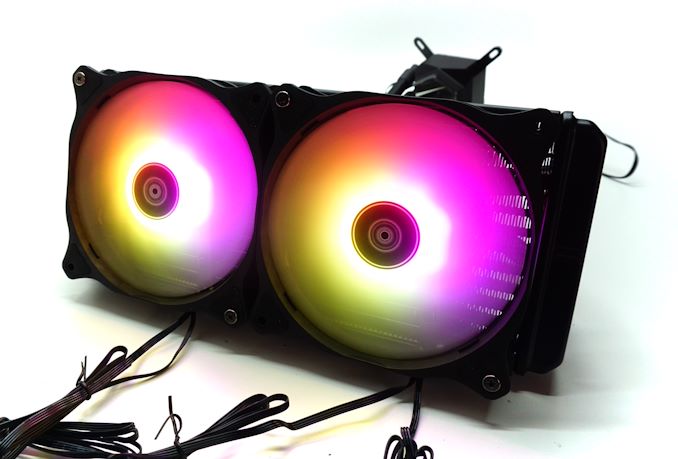The SilverStone Permafrost PF120, PF240, and PF360 ARGB AIO Coolers Review
by E. Fylladitakis on June 17, 2020 10:00 AM ESTConclusion
SilverStone released the Permafrost series as competitively priced, quality AIO coolers that also feature RGB lighting. It is apparent that the company’s engineers did not try to make the coolers extravagant in any given way, but to design products that mix solid aesthetics, reliability, and performance, all while remaining reasonably priced.
Overall, the thermal performance of the new Permafrost series is good, although unsurprising for coolers of their size. This was to be expected, as they are using virtually the same tried-and-true radiators that many other manufacturers have been using for many years now, with the design team focusing their efforts on the main block. There is little to be gained by fiddling with the mini pump when limited by the small available power, but SilverStone’s engineers managed to maintain good flow performance while considerably reducing the pump’s noise output.
Each of the three Permafrost coolers seems to have a different performance profile and, thus, targets a different group of users. The PF240 seems to be the most balanced of the three coolers, being reasonably sized and capable of closing near the performance of the PF360 if it has to. The larger PF360 does not really stand out in terms of raw thermal performance but is capable of maintaining that performance even if the airflow drops greatly. Finally, the small PF120 offers acceptable thermal performance and relatively low noise levels in a small, easily handleable package that should fit inside even the smallest of PC cases.
While SilverStone could not make substantial improvements regarding the thermal performance of their AIO coolers, they did manage to get ahead in terms of acoustics. Most of that improvement seems to be coming from the better pump engine and the high quality fan engines. No matter the reason, the Permafrost PF240 and PF360 tend to offer better thermal performance at lower noise levels than many similarly sized, older AIO coolers, which will definitely entice users who enjoy low noise levels.
As for the RGB lighting, its application on the Permafrost coolers is simplistic but effective. The LED lighting is bright enough and the fans glow brilliantly into a dark environment. It is compatible with nearly all current RGB motherboards and can be controlled via the motherboard’s software. For users that do not have a compatible motherboard, the RGB lighting can be effectively programmed via the included controller that includes several fancy and static lighting effects, but the user will have to access the inside of the system for each program/brightness change.
In conclusion, with the release of the Permafrost series, SilverStone brought three very well balanced AIO coolers with RGB support into the market. The three coolers are sensibly priced, with the 240mm model running for $99 and even the largest 360mm model and can be frequently found for $129 – and they're often on sale for less, making them a serious threat to the competition.













71 Comments
View All Comments
drexnx - Wednesday, June 17, 2020 - link
wish we'd get a teardown of the pumpblock, seems like after many years of asetek stagnation we're finally seeing performance move forward again in AIOswarrenk81 - Wednesday, June 17, 2020 - link
page 2 typo: "The bottom of the main block assembly reveals a sizable, square cooper block."eastcoast_pete - Wednesday, June 17, 2020 - link
Maybe my information is outdated, but isn't there a small, but significant difference in the overall shape (slightly concave vs. slightly convex) of AMD's vs. Intel's heat spreaders that can really affect cooling performance? I may have missed it, but are the copper blocks "fitted" to the respective CPU type? If not, some of that cooling potential is likely being wasted.Also, with current "enthusiast" kind Intel CPUs reaching over 250 W TDP at peak use, any chance of showing results with a steady 250 or 200 W load?
PeachNCream - Wednesday, June 17, 2020 - link
I'm seeing a drop down menu option to select various wattage from 60W up 340W including the 200W and 250W options you would like.eastcoast_pete - Wednesday, June 17, 2020 - link
Yeah, I should have been clearer; that comment/request was in regard to the last graph, which doesn't have the drop-down selection, and is for 100W only.Interestingly, no response by anyone yet on the question about the shape of the copper block; I didn't think it'd matter, until I read some tests that showed a pretty significant difference depending on how true the heatsink matches the heat spreader's shape
p1esk - Wednesday, June 17, 2020 - link
"the contact plate is not large enough to cover Ryzen Threadripper processors"OK thanks
Arbie - Wednesday, June 17, 2020 - link
For those interested, the Noctua NH-D15 is close to the Fractal Design S36 here, except that there's no data on Noctua above 38 dBA:https://www.anandtech.com/show/14621/the-noctua-nh...
Beaver M. - Saturday, June 20, 2020 - link
And thats with 2 fans.Plus you always have the option to sound-insulate your case, which helps a lot on air coolers, while the pumps of AIOs are pretty impossible to get silent due to their vibration.
edwardav54 - Wednesday, June 17, 2020 - link
No RGB please.AdditionalPylons - Thursday, June 18, 2020 - link
If my colleague working with permafrost research would be into stationary PCs I'd buy this for him at once. =)That said, I may consider this in a mITX build for myself at some point.
(I've only had one AIO - an Asetek for LGA775, years ago. Wasn't bothered with the relatively minor pump noise. Have since used Noctua air coolers and been happy with that.)